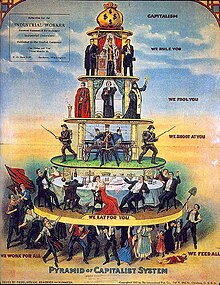
The 1911 "Pyramid of Capitalist System" cartoon is an example of socialist critique of capitalism and of social stratification
source: https://en.wikipedia.org/wiki/Social_stratificationSummary:
Layering refers to the hierarchical arrangement of people in society. Layering can be seen in many areas of society. Depending on economic factors, it can be described as rich and poor, political factors such as politicians and ordinary citizens, in the past, aristocrats and slaves depending on their status. These factors rank people and discriminate. Inequality means that people do not have access to rare and valuable resources in society. Health care, education, occupation, property and land ownership, housing and government policies are those resources.
Functional theory states that it contributes in some way to the overall stability of a larger system. On the other hand, conflict theory argues that layering does not function and is harmful to society. Layering claims to be beneficial to the rich and powerful at the expense of the poor.
What was interesting/What did we learn:
The position of functional theory and conflict theory of layering was interesting.
This is because the two theories have the same attitude toward capitalism. And we empathize with the reasons why inequality continues in the society proposed by sociologist Joel Karen, because the rich seem to have created laws and systems to maintain their current social structure so that they won't be taken away by it by familiarity with it.
Discussion point:
Rich people often share political power, then, are there proportionality between the degree of wealth and political power? If not, what is the case?
No comments:
Post a Comment